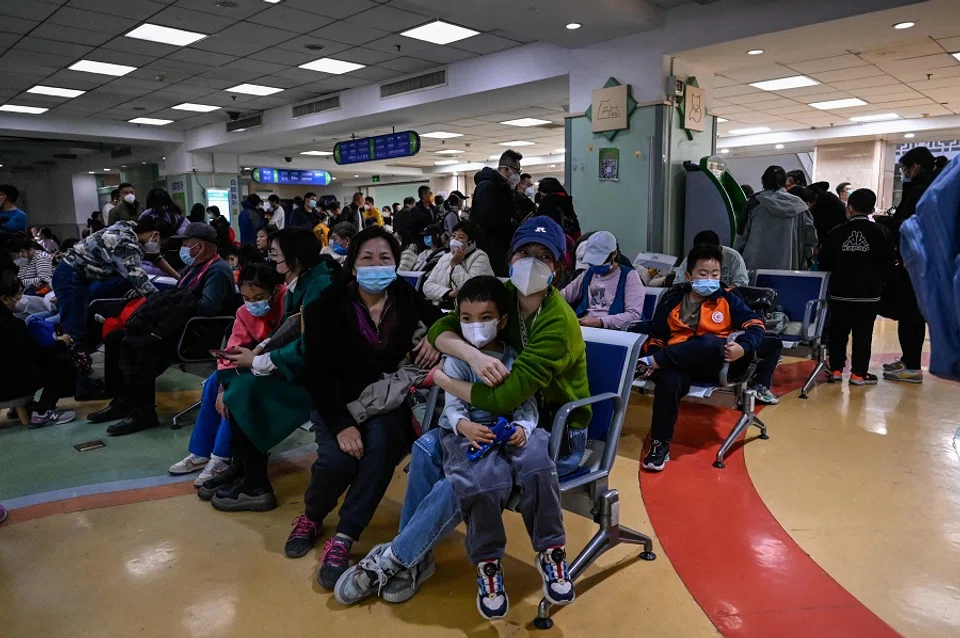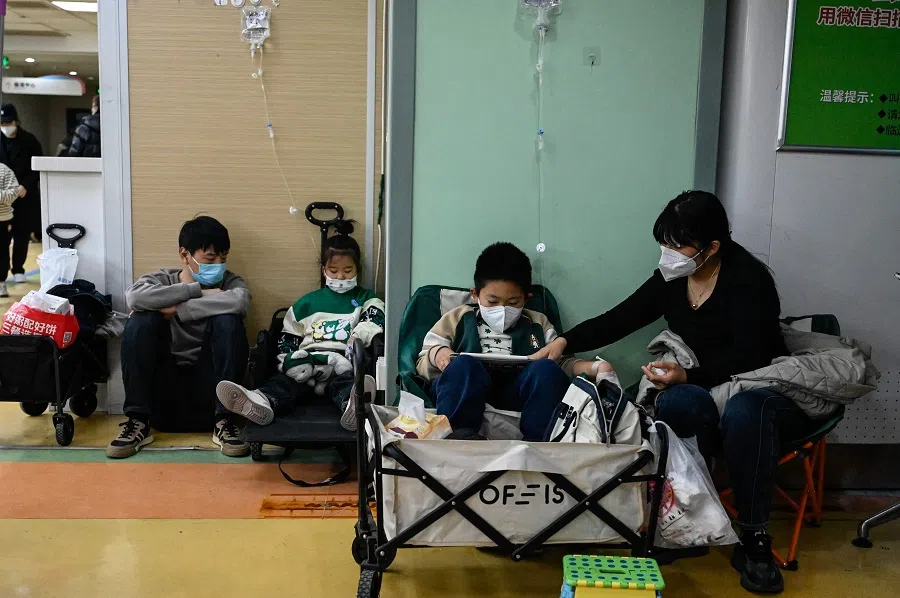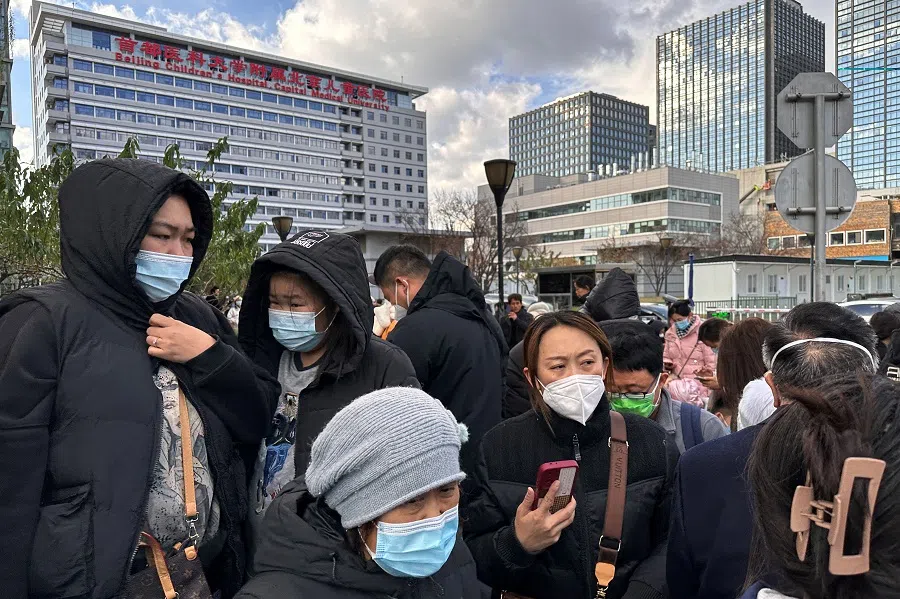Packed children's hospitals in Beijing reflects China's social conditions
Academic Zhang Tiankan notes that crowded children's hospitals in Beijing actually reflect social conditions, such as mindsets towards hospital treatment being the best and also the stressful education system, as children do their homework even while hooked up to IV drips. In many cases, rushing to the hospital as an immediate response could do more harm than good and be a great drain on public resources.

These days, from 4pm to 2am, Xiaoye Clinic of the internal medicine department at Beijing Children's Hospital turns into one of the most crowded places in the city, with some 4,000 to 5,000 people confined in a space measuring just a few hundred square metres. The air is pierced by the smell of medicine, the cries of children and the blaring patient call system from the clinic counter.
At 1am on 25 November, a digital screen in Xiaoye Clinic calls for patients with queue numbers in the 1200s to submit their test reports at the counter. At this time, there were still dozens of parents with a queue number in the 1100s standing in queue outside the clinic. A medical staff says this batch of patients in the 1200s is the third batch for that day. At the IV drip centre on the second floor, the queue number is already at 2028.
The packed Beijing Children's Hospital is the next medical crisis to attract attention since the Covid-19 pandemic. Many children even do their homework while hooked up to IV drips; there is a sense of helplessness, even dark humour, as various systemic problems in China are revealed, including in healthcare and education. These situations are not unique to Beijing Children's Hospital, but have spread to many respiratory and paediatric departments in hospitals across Beijing and other cities.
The flip side of this red-hot situation highlights a longstanding problem in the medical treatment of Chinese patients: unequal access to medical resources...

However, it should be recognised that with so many parents flocking to Beijing Children's Hospital to have their children treated, it shows that the medical standards, experience and service attitude of the medical staff at the hospital are indeed top notch, and further evidence that parents trust the hospital. Not only are parents from the capital city and its suburban regions such as Yanqing and Miyun bringing their children to Beijing Children's Hospital, but so are parents from surrounding cities such as Tianjin.
Everyone in Beijing
The flip side of this red-hot situation highlights a longstanding problem in the medical treatment of Chinese patients: unequal access to medical resources, so that almost all patients across the country have to seek medical treatment in large hospitals in Beijing and Shanghai.
While it is certainly wise to seek treatment in reputable hospitals for serious, critical and rare illnesses, if people are still heading to large hospitals for common illnesses such as colds, flu and mild pneumonia, it only shows that medical mindsets and behaviours have not changed significantly.
These common illnesses can be seen by doctors at community hospitals within a few minutes after registration, which is far more efficient than gathering at a children's hospital and waiting for over ten hours or even a whole day before one can see a doctor.
Some researchers claim that this wave of infections has to do with people wearing masks over the three years of the pandemic, which reduced the chances of catching infectious germs.

The logic behind flocking to large and reputable hospitals to seek treatment is the belief that only such hospitals can provide good and fast treatment, which in turn has to do with people's perceptions and understanding of the cause and progression of diseases.
The Beijing Centre for Disease Control and Prevention assessed that the current wave of mycoplasma infections among children in Beijing and across the country is not only caused by mycoplasma pneumoniae but also influenza, adenovirus and respiratory syncytial virus, with mycoplasma pneumoniae slipping to fourth place.
These pathogenic infections (including upper and lower respiratory tract symptoms) are all self-limited diseases, that is, those that resolve on their own. As long as their immune systems are functioning, patients can recover in seven to ten days with rest and a balanced diet, without medication. However, when multiple symptoms occur simultaneously, such as persistent high fever, worsening cough, poor mental state, projectile vomiting, rash or other changes in condition, medical treatment should be sought promptly.
Parents think that their children will recover faster if they are treated at the hospital. This has given rise to a unique phenomenon: children are mostly put on the drip, with the thought that this will hasten recovery...
Worshipping the IV drips
Some researchers claim that this wave of infections has to do with people wearing masks over the three years of the pandemic, which reduced the chances of catching infectious germs. This led to an "immunity debt" because people had little contact with pathogens and could not build up their immune systems during "zero Covid".
Compared to adults with more robust and developed immune systems, children have lower immunities because they do not have acquired immunities. They may be more susceptible to respiratory infections during the flu season, which runs from fall to spring of the following year. These infections may also be more severe than in the past.

These situations have caused general concern among parents; when a fever lasts several days with no signs of abating even with medication, they worry that it could worsen into pneumonia and head straight for paediatric hospitals.
Parents think that their children will recover faster if they are treated at the hospital. This has given rise to a unique phenomenon: children are mostly put on the drip, with the thought that this will hasten recovery. However, an IV drip is not a cure-all. It has no impact on recovery time for a common cold or flu, and is no better than oral medications for mycoplasma infections or pneumonia.
A large number of children have taken IV drips due to this wave of respiratory diseases. Treatment-wise, this seems to be taking a step backwards, and pays no heed to the World Health Organization's recommendation, which is to avoid intramuscular injection if oral medication would suffice, and to avoid an intravenous injection when intramuscular injection would suffice.
Whether in China or elsewhere, the many side effects and complications arising from IV drips have long been a reminder that for illnesses that are not severe, it is best to stick to oral medication. Unnecessary IV drips for children could lead to long-term and more serious consequences than a respiratory infection. Although the impact is not immediately visible, potential risks include clogged capillaries, granuloma, and even the presence of large amounts of microplastics in the fluids.
... if the education departments and schools put in regulations to excuse sick children from school and homework, allowing them to rest at home and recover, and attend make-up classes later, this might help the children's recovery.
Sick and doing homework
This wave of respiratory illnesses has also impacted children's education, and is clear evidence of intense educational involution (内卷), with children doing their homework while on the drip.
Even though educational departments state that children should not be made to do school work while they are sick, given serious involution, parents and children cannot obey. One day without tackling homework leads to accumulated homework, and one day's absence from school could lead to a slide in the classroom rankings - all this will have an impact on future education, so parents and children dare not take it lightly.
However, this will lengthen the recovery period - an illness that normally takes a week to recover from now takes two weeks, or even longer. With parents and children all anxious, it is no surprise that there is a mass influx of sick children heading towards paediatric hospitals to get an IV drip.

Hence, if the education departments and schools put in regulations to excuse sick children from school and homework, allowing them to rest at home and recover, and attend make-up classes later, this might help the children's recovery.
The fact is, flu, adenovirus, respiratory syncytial virus and respiratory diseases arising from mycoplasma infections are all self-limiting diseases that rarely develop into pneumonia. Even without medication, recovery can be expected within seven days, while oral medication is the best form of medication if need be.
The flu could cause another greater spike in the days to come. According to China's Center for Disease Control's weekly influenza report, the flu is now on the rise in northern China and has not peaked yet, and could get worse in the coming few weeks; cases are emerging in southern China.
Collectively, both regions could form a spike in influenza cases in China, and more children would get infected. If there is a shift in mindset towards home rest or seeking treatment at a regional hospital first, that could prevent a squeeze on medical resources and cross-contamination cases, and mitigate further future risks.



![[Big read] Love is hard to find for millions of rural Chinese men](https://cassette.sphdigital.com.sg/image/thinkchina/16fb62fbcf055b710e38d7679f82264ad682ce8b45542008afeb14d369a94399)
![[Big read] China’s 10 trillion RMB debt clean-up falls short](https://cassette.sphdigital.com.sg/image/thinkchina/d08cfc72b13782693c25f2fcbf886fa7673723efca260881e7086211b082e66c)
